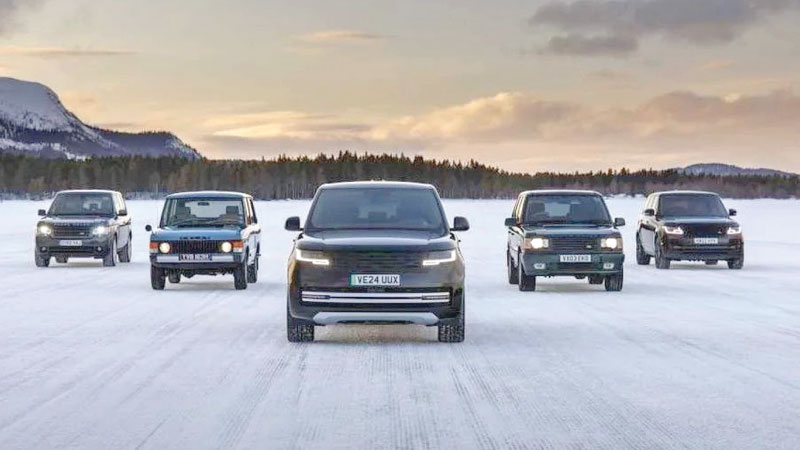 Jaguar, which forms the “J” part of Jaguar Land Rover (JLR), has had an all-electric car for quite a few years. There are a few examples of the Jaguar I-Pace on our roads.
Jaguar, which forms the “J” part of Jaguar Land Rover (JLR), has had an all-electric car for quite a few years. There are a few examples of the Jaguar I-Pace on our roads.
But what everyone (at least those who can afford it) wants is a Range Rover Electric and JLR is about to deliver just that – though only next year. Right now, undisguised prototypes of the new Range Rover Electric are undergoing testing in various parts of the world, including in arid deserts and the frozen Arctic. The cars that will come to tropical countries such as Sri Lanka will be fully conditioned to endure our hot climates.

Thomas Muller
But right now, JLR is focusing on cold weather testing inside the Arctic Circle. This is especially important, given that the EV battery has been designed and engineered entirely in-house by JLR.
The high‑voltage 800V battery is optimised for energy density, range and charging times. Engineered to provide the kind of effortless performance and customary refinement expected of a Range Rover, the electric luxury SUV benefits from cell‑to‑pack architecture providing the best possible performance. Range Rover Electric’s 117kWh battery is fully encased and smartly packaged, consisting of 344 prismatic cells in a double‑stacked layout.
Enduring up to nearly 100,000 Km of accumulated testing across frozen lakes and land tracks, the latest winter season in northern Europe has allowed engineers to put Range Rover Electric’s advanced thermal management system through a demanding testing schedule. The frozen lake tracks also provided invaluable testing conditions for dynamics, including single pedal driving capability and switchable, twin‑chamber air‑suspension.
ThermAssist technology
A key part of the latest development phase in Arjeplog, Sweden, has been for engineers to validate Range Rover Electric’s new ThermAssist technology. The advanced on‑board thermal management system reduces heating energy consumption by up to 40 percent and aims to recover heat to warm the propulsion system or cabin in ambient temperatures as low as ‑10C.
The advanced heat management technology ensures Range Rover Electric delivers optimised driving range, even in the coldest temperatures. It also minimises the impact of extreme temperatures on charging performance, reassuring drivers that when they plug the vehicle in, charging capability is preserved. Occupants also benefit from a consistently warm cabin, despite any exterior chill.
“Rigorous testing procedures in extreme and unpredictable conditions like those experienced in Arjeplog are crucial to Range Rover Electric’s real‑world reliability and resilience. Our second winter season in the Arctic Circle has provided the perfect opportunity for us to put our new ThermAssist technology to the test, and it has surpassed our expectations. It will help to ensure Range Rover Electric’s range remains intelligently optimised while also ensuring charging speeds are maintained when a top‑up is required,” says Thomas Müller, Executive Director, Product Engineering, JLR.
Single pedal driving
All‑terrain capability and refinement are core elements of the Range Rover experience. That will continue with electric propulsion, with the implementation of many advanced technologies.
Range Rover Electric takes single pedal driving to an advanced new level. In addition to slowing the vehicle and delivering charge into the battery from regenerative braking, it is also tuned to work with Terrain Response. Single pedal driving will bring the vehicle to a complete stop and will engage Hill Hold, enabling the driver to move off again without having touched the brakes at any point.
Taking to the ice tracks of the Arctic Circle has demonstrated how Range Rover Electric’s all‑wheel drive technology can handle all surfaces. Thanks to its accurate torque delivery, its Intelligent Driveline Dynamics (IDD) technology is able to distribute rear torque from 100 percent to 0 percent to prevent any loss of traction. Working with Integrated Traction Management (ITM), traction stability is maintained – controlling motor speed within 50 milliseconds and managing slip up to 100 times quicker than an Internal Combustion Engine (ICE) vehicle equivalent.
Following its second season in Arjeplog, Range Rover Electric prototypes will continue their demanding testing and development program ahead of customer orders.
Every current Range Rover (RR, Velar and Evoque) is already available as an electric hybrid. The Range Rover PHEV powered by a 3-litre turbo-charged petrol engine will soon be on Sri Lankan roads. Range Rover is one of the world’s leading British luxury brands, sold in 121 countries. It belongs to the JLR house of brands together with Land Rover Defender, Discovery and Jaguar. It is owned by the Tata Group.






